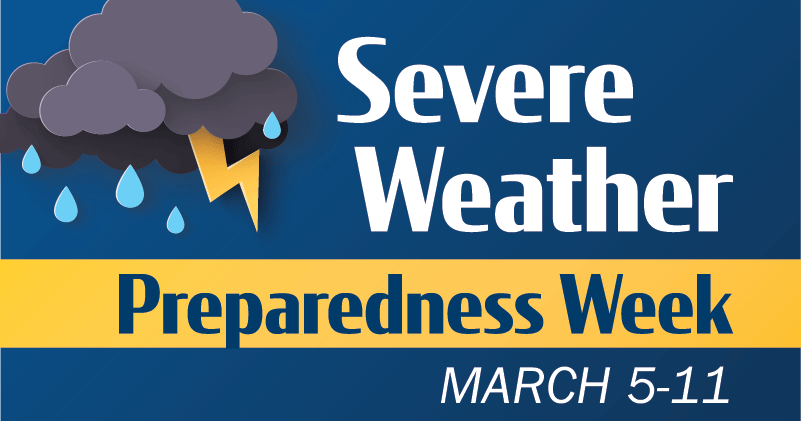
Topics
- Monday: Severe Thunderstorms and Tornadoes
- Tuesday: Severe Weather Alerts and Tornado Drill
- Wednesday: High Winds, Hail and Tornadoes
- Thursday: Lightning
- Friday: Flash Floods
- Saturday: Make a Plan
When your area is under a tornado warning, or if you see a tornado approaching, you should seek shelter immediately! Most injuries associated with high winds are from flying debris, so remember to protect your head. The following are safety tips for seeking shelter during high winds and tornadoes.
Tornado Safety Rules
If you are in a home or small business:
Go to the basement or a small interior room such as a closet, bathroom or interior hallway without windows on the lowest level. Put as many walls between yourself and the outside as possible. If possible, get under something sturdy, such as a heavy table, or use a mattress to protect yourself from flying debris. Most injuries associated with high winds are from flying debris, so remember to protect your head. If available, put on a bicycle or motorcycle helmet to protect yourself from head injuries.
If you are in a large business, school, hospital, shopping center or factory:
Go to the designated shelter area. If a shelter area is not available, the best place is to go to an interior hallway on the lowest level. Stay away from the structurally weaker portions of buildings, such as windows and rooms with expansive roofs, which are more likely to collapse when tornadoes strike.
If you are in a mobile home or home on stilts:
Get out and take shelter in a sturdy building or storm shelter. If there is not one nearby, take shelter in the most interior room that has no windows, such as an interior bathroom or closet.
If you are outside with no shelter available:
There is no single research-based recommendation for what last-resort action to take, because many factors can affect your decision. Possible actions include:
- Immediately get into a vehicle, buckle your seat belt and try to drive to the closest sturdy shelter. If your vehicle is hit by flying debris while you are driving, pull over and park and cover your head with your arms and a blanket, coat or other cushion if possible.
- Lie in an area noticeably lower than the level of the roadway and cover your head with your arms and a blanket, coat or other cushion if possible.
- Do not get under an overpass or bridge. You are safer in a low, flat location.
- Never try to outrun a tornado in urban or congested areas in a car or truck. Instead, leave the vehicle immediately for safe shelter.
While hail and straight-line winds generally do not garner the same attention or respect as tornadoes, they can be just as deadly! Hail can exceed the size of softballs and fall at speeds of over 100 mph, seriously injuring or killing anyone in its path. Straight-line winds can topple trees onto cars, houses, and power lines. Many deaths from straight-line winds are the result of trees falling onto the person, whether they are outside, in their house or driving in their car. Strong straight-line wind events can even destroy buildings, especially mobile homes and manufactured homes.
